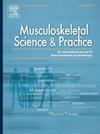Prevalence of cervical, vestibulo-ocular and or physiological impairments in symptomatic individuals 4 weeks to 6 months post-concussion
IF 2.2
3区 医学
Q1 REHABILITATION
引用次数: 0
Abstract
Background
Deficits in individual measures relating to cervical, vestibulo-ocular or physiological subsystems have been observed in symptomatic individuals post-concussion. Few studies consider the presence of several impairments within and across each of these three subsystems.
Objective
To evaluate the prevalence of cervical, vestibulo-ocular and or physiological impairment in symptomatic individuals four weeks to six months post-concussion.
Setting
Tertiary hospital and university.
Design
Exploratory observational cohort study.
Methods
Participants were deemed to have: Cervical impairment if positive on at least 3/7 cervical tests, vestibulo-ocular impairment if positive on at least 2/11 tests and physiological impairment if they failed the Buffalo Concussion Treadmill Test.
Results
Impairment across all three subsystems was detected in 29 % of participants, two subsystems in 47 %, one in 23 % and none in 3 %. Eighty-five percent had cervical impairment.
Conclusion
There was a high prevalence of multiple subsystem impairments and the majority had a cervical impairment across a number of cervical tests. Hence, in clinical practice, it is essential to perform a detailed physical examination across all subsystems and consider clinical implications of cervical impairments in the majority of individuals four weeks to six months post-concussion.
脑震荡后4周至6个月有症状个体的颈椎、前庭-眼和/或生理损伤发生率
背景:在有症状的脑震荡后个体中观察到与颈椎、前庭-眼或生理子系统相关的个体测量缺陷。很少有研究考虑到这三个子系统内部和之间存在几种损伤。目的评价脑震荡后4周至6个月有症状者颈椎、前庭-眼和(或)生理损伤的发生率。三级医院和大学。设计探索性观察队列研究。方法:如果参与者在至少3/7的颈椎测试中呈阳性,则认为他们有颈椎损伤;如果在至少2/11的测试中呈阳性,则认为他们有前庭-眼部损伤;如果他们在布法罗脑震荡跑步机测试中失败,则认为他们有生理损伤。结果29%的参与者在所有三个子系统中检测到损伤,47%的参与者在两个子系统中检测到损伤,23%的参与者在一个子系统中检测到损伤,3%的参与者没有检测到损伤。85%的人有宫颈损伤。结论多子系统损伤发生率高,且多项宫颈检查均以宫颈损伤为主。因此,在临床实践中,有必要对所有子系统进行详细的体格检查,并考虑大多数人在脑震荡后4周到6个月的颈椎损伤的临床意义。
本文章由计算机程序翻译,如有差异,请以英文原文为准。
求助全文
约1分钟内获得全文
求助全文
来源期刊

Musculoskeletal Science and Practice
Health Professions-Physical Therapy, Sports Therapy and Rehabilitation
CiteScore
4.10
自引率
8.70%
发文量
152
审稿时长
48 days
期刊介绍:
Musculoskeletal Science & Practice, international journal of musculoskeletal physiotherapy, is a peer-reviewed international journal (previously Manual Therapy), publishing high quality original research, review and Masterclass articles that contribute to improving the clinical understanding of appropriate care processes for musculoskeletal disorders. The journal publishes articles that influence or add to the body of evidence on diagnostic and therapeutic processes, patient centered care, guidelines for musculoskeletal therapeutics and theoretical models that support developments in assessment, diagnosis, clinical reasoning and interventions.
 求助内容:
求助内容: 应助结果提醒方式:
应助结果提醒方式:


